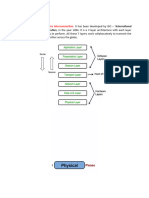Layered Architecture
Layered architecture in networking refers to dividing the functions of communication
into different, independent layers, each of which handles a specific aspect of network
communication. This structured approach provides a modular framework, making it
easier to design, maintain, and troubleshoot network systems.
Key Aspects of Layered Architecture:
1. Modularity: Each layer in the architecture has a distinct purpose and set of functions.
By isolating these functions, it’s easier to focus on specific tasks within a layer without
affecting the others.
2. Interoperability: Standardizing the layers and defining their functions ensures that
devices from different vendors can communicate as long as they follow the same
protocols within each layer.
3. Simplified Development: Network designers can develop each layer independently,
testing and upgrading layers as needed without overhauling the entire system.
4. Abstraction: Each layer hides its complexity from the others. For example, the
application layer doesn’t need to know how the physical layer transmits bits; it only
cares about sending and receiving data.
The most common layered models in networking are:
- OSI Model: A seven-layer model that provides a comprehensive framework.
- TCP/IP Model: A simpler four-layer model based on the protocols used in the Internet.
Protocol Layering
Protocol layering is a method used in layered architectures to define the specific set of
rules, or protocols, each layer must follow to accomplish its designated functions.
Protocols within each layer govern how data is formatted, transmitted, received, and
interpreted at that level.
In a layered architecture:
- Each layer has its protocol(s) that specify how the data at that layer should be
handled.
�- Layered protocols depend on each other in a hierarchical manner, where each layer
provides services to the layer above it and depends on the services of the layer below it.
How Protocol Layering Works:
1. Encapsulation: Each layer packages the data it receives from the layer above into a
new “envelope” (or header) that contains specific information needed by that layer’s
protocol.
- For example, the transport layer encapsulates application data with TCP or UDP
headers, adding inform`ation such as port numbers and sequence numbers.
2. Decapsulation: When data is received, each layer removes the encapsulation added
by the corresponding layer on the sending side. The data is then passed up the stack,
layer by layer, until it reaches the application layer.
3. Service Provision: Each layer provides specific services to the layer above it. For
instance, the transport layer provides reliable delivery services to the application layer
by managing packet loss, ordering, and error-checking (in TCP).
4. Peer-to-Peer Communication: Protocols within the same layer on different devices
(e.g., transport layer on two computers) communicate with each other, using headers to
interpret the data properly.
Example: TCP/IP Protocol Stack
In the TCP/IP protocol stack:
- Application Layer Protocols (e.g., HTTP, FTP) communicate directly with each other.
- Transport Layer Protocols (e.g., TCP, UDP) handle the segmentation and reassembly of
data, as well as error checking and flow control.
- Network Layer Protocols (e.g., IP) manage logical addressing and routing.
- Data Link Layer Protocols (e.g., Ethernet, Wi-Fi) handle physical addressing and the
local transmission of data.
Each layer’s protocol has specific responsibilities and interacts with the protocols of
the same layer on other devices (for example, the IP protocol on a source device
communicates with the IP protocol on a destination device). This creates a predictable
and organized structure, allowing different network devices to function together
seamlessly.
�Benefits of Protocol Layering
1. Compatibility and Flexibility: Protocol layering ensures that different network
components can interoperate as long as they adhere to the protocols of each layer.
2. Easier Troubleshooting and Upgrades: Problems can be isolated to specific layers,
and individual protocols can be updated without redesigning the entire network.
3. Enhanced Communication: Layering protocols provide standardized communication,
enabling networks to scale and support a wide range of devices and applications.
In summary, layered architecture provides a modular framework, and protocol layering
defines the specific rules and interactions within each layer, ensuring standardized
communication. Together, they allow networks to handle complex communication
tasks effectively and consistently.
1. Application Layer
- Purpose: This is the topmost layer, closest to the end-user, and it’s responsible for
enabling communication between applications across the network.
- Key Protocols:
- HTTP (HyperText Transfer Protocol): Used for accessing websites on the internet.
- SMTP (Simple Mail Transfer Protocol): Used for sending emails.
- FTP (File Transfer Protocol): Used for transferring files between computers.
- DNS (Domain Name System): Translates human-readable domain names (like
www.example.com) into IP addresses.
- Functionality: It provides various services based on application requirements, such
as file transfer, email, and web browsing.
2. Transport Layer
- Purpose: This layer ensures reliable data transfer between two devices on the
network, managing communication between applications.
- Key Protocols:
� - TCP (Transmission Control Protocol): Provides reliable, ordered, and error-checked
delivery of data. It’s used for applications where data accuracy is critical, like web pages
and emails.
- UDP (User Datagram Protocol): Offers a faster, but less reliable, form of data
delivery. It’s used for real-time applications, like video streaming and online gaming,
where speed is prioritized over reliability.
- Functionality: The transport layer is responsible for flow control, error handling, and
ensuring data packets reach the correct application on the destination device.
3. Network Layer
- Purpose: The network layer manages data transfer across multiple networks and is
responsible for routing packets from the source to the destination.
- Key Protocols:
- IP (Internet Protocol): Defines IP addresses and is responsible for routing data
packets based on these addresses. IPv4 and IPv6 are the two versions commonly used.
- ICMP (Internet Control Message Protocol): Used for diagnostic and error-reporting
functions, such as indicating when a network path is unavailable.
- ARP (Address Resolution Protocol): Resolves IP addresses to MAC (Media Access
Control) addresses on local networks.
- Functionality: This layer determines the best path for data to travel across
interconnected networks, managing data packet forwarding and addressing.
4. Data Link Layer
- Purpose: The data link layer handles communication between devices on the same
local network, ensuring that data can be transferred from one device to another over
physical connections.
- Key Protocols:
- Ethernet: A common protocol for wired networks, defining how data is formatted
and transmitted on local networks.
- Wi-Fi (IEEE 802.11): A standard for wireless networking, defining how data is
transmitted over wireless local networks.
- PPP (Point-to-Point Protocol): Used in direct connections between two nodes, such
as dial-up connections.
� - Functionality: The data link layer packages data into frames and manages error
detection, addressing on local networks, and sometimes error correction.
5. Physical Layer
- Purpose: The physical layer is the lowest layer, concerned with the physical aspects
of data transmission, including the hardware components of the network.
- Key Protocols:
- This layer doesn’t typically have protocols in the same way as higher layers but
instead defines standards for hardware and media (such as cables, connectors, and
signal types).
- Functionality: The physical layer transmits raw bitstreams over a physical medium
(like electrical signals over a copper cable or light pulses over fiber optics) and defines
how devices connect and communicate at the hardware level.
Summary of the Internet Protocol Stack
Each layer of the Internet protocol stack serves a specific role:
- Application Layer provides end-user services.
- Transport Layer ensures data reliability and correct delivery to applications.
- Network Layer routes data across different networks.
- Data Link Layer manages direct data transfer on local networks.
- Physical Layer handles the hardware and physical data transmission.
This layered approach allows networks to be more flexible and modular, enabling
interoperability and simplifying the design and maintenance of network systems.























































































